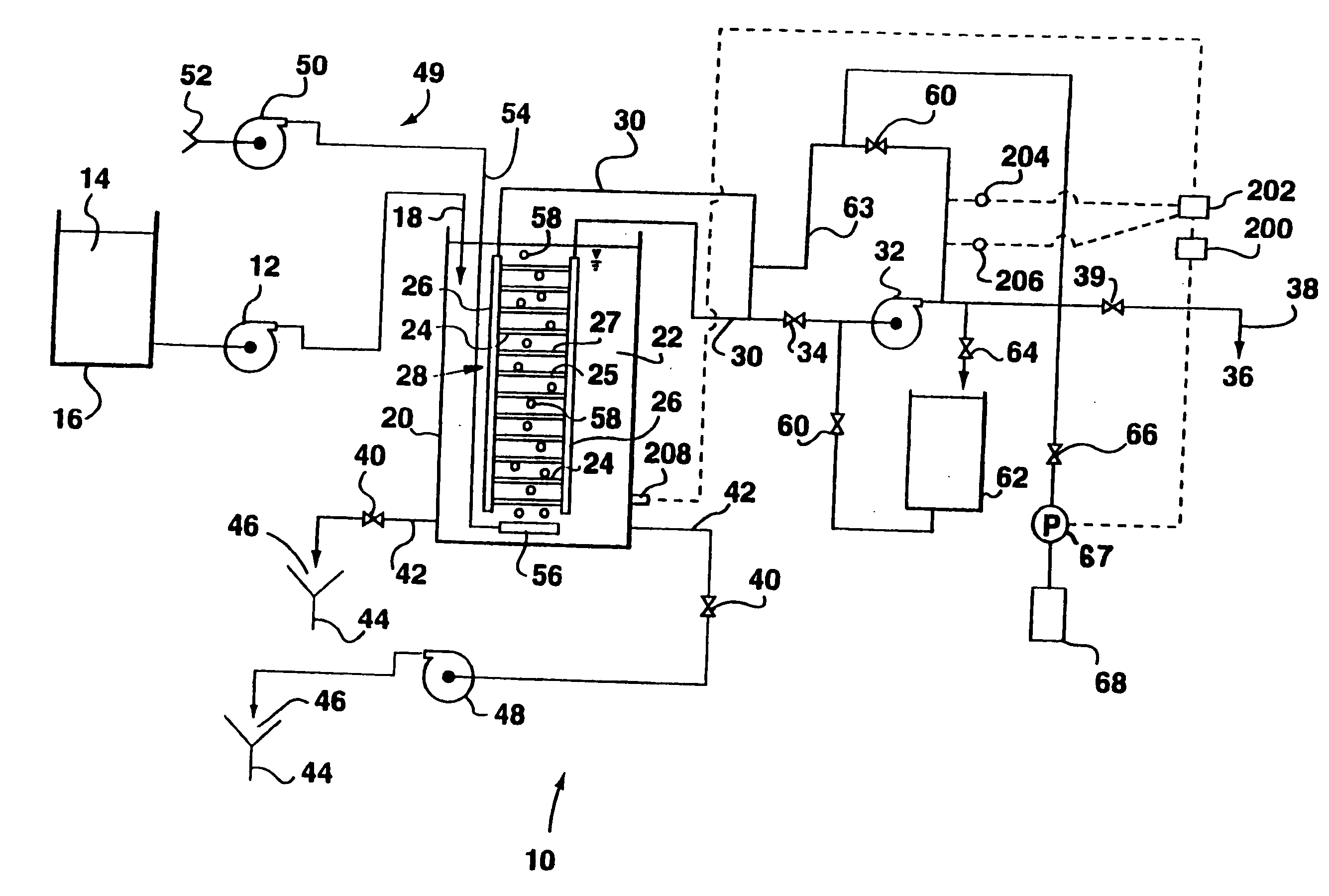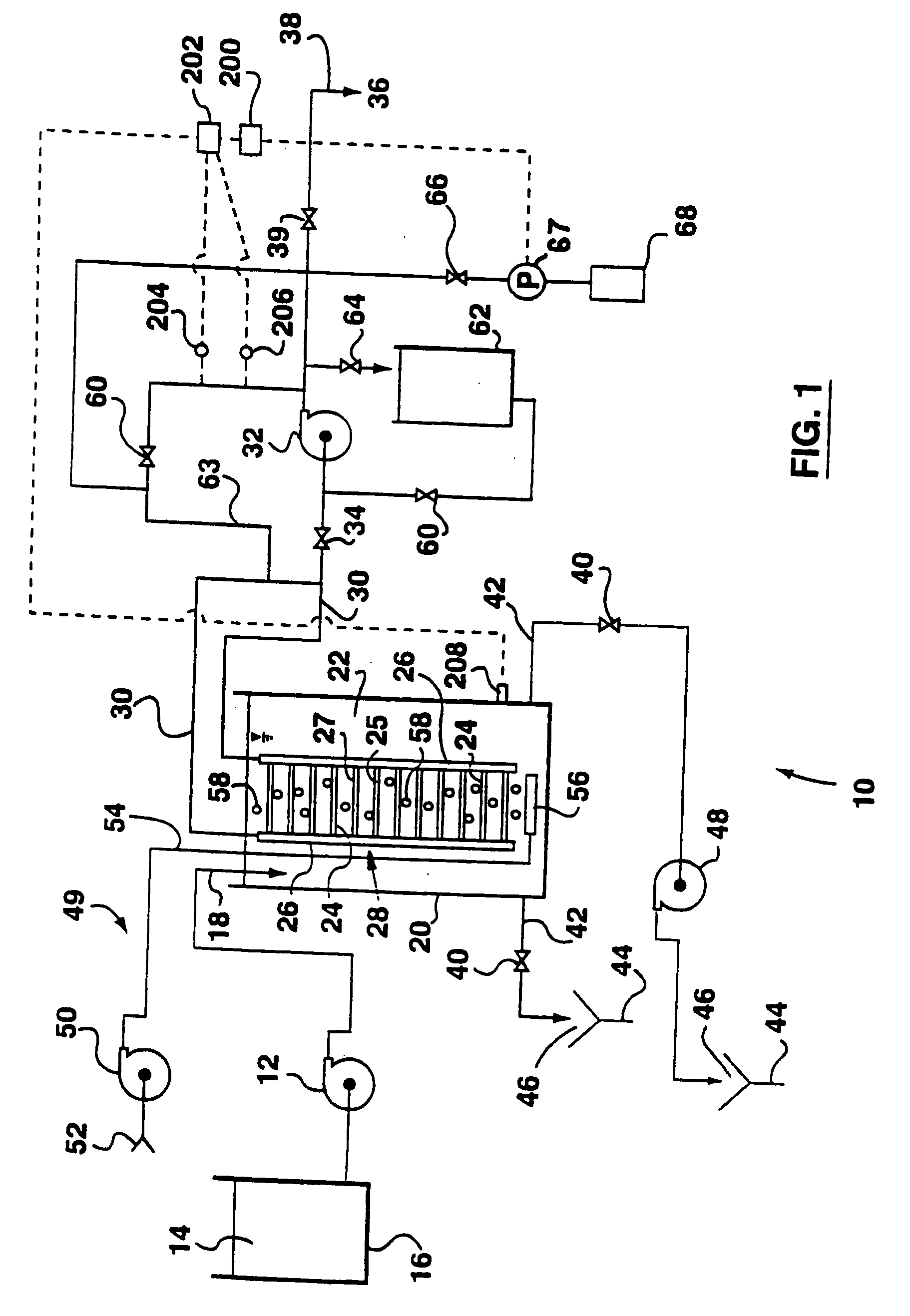Chemical cleaning backwash for normally immersed membranes
- Summary
- Abstract
- Description
- Claims
- Application Information
AI Technical Summary
Benefits of technology
Problems solved by technology
Method used
Image
Examples
example 1
[0071] A small membrane module of horizontal hollow fiber membranes having approximately 28 m2 of surface area was backwashed with 10-20 ppm chlorine for three minutes every two hours. The chemical backwash was started at the same time as the tank drains were opened but, because of the size of the tank, draining the tank finished before the chemical backwashing finished. The feed water was from a lake and had a pH of 7.5, a temperature of 20 C, turbidity of 10-15 ntu and TOC of about 5-8 mg / L. The process was run for over 30 days at a 95% recovery rate at two different permeate fluxes-20 L / m2 / h and 30 L / m2 / h. In both cases, acceptable permeability was maintained over extended periods of time. FIG. 5 shows the permeability of the membranes over time at each permeate flux.
example 2
[0072] A membrane module of horizontal hollow fiber membranes was backwashed with 25 ppm chlorine for 10 minutes once per day. The chemical backwash was performed substantially while draining the tank except that a first pulse of 2 minutes duration was performed with the tank full. Subsequent pulses (8 per cleaning event) were 15 seconds in duration separated by 45 second periods in which chemical cleaner was not delivered to the membranes. The feed water had a temperature of 25 C, turbidity of 1-5 ntu and TOC of about 2-5 ppm. The process was run for over 30 days at between 90% and 95% recovery rate at a permeate fluxes of 30 L / m2 / h. Measured permeability (at 20C) was between about 145 and 165 L / m2 / h / bar for over 30 days and indicated a drop in permeability of only between 5 and 10 L / m2 / h / bar over the duration of the test. In both cases, acceptable permeability was maintained over extended periods of time.
example 3
[0073] An experimental membrane bioreactor using a ZEEWEED 500 membrane module having 46 square meters of membrane surface area was built for treating waste water and, in particular, for carbon oxidation, nitrification and phosphorus removal. At all times, the flow rate of permeate through the membranes was maintained at 25.5 L / m2 / h and the solids concentration in the bioreactor averaged between 15 g / l and 20 g / l. The average flow through the bioreactor was 1,000 cubic meters per day and the peak flow was 2,000 cubic meters / day.
[0074] The bioreactor was first operated without cleaning according to the invention for 90 days. Permeability was not sustainable and decreased continuously. At the end of this time, permeability of the membranes had dropped to less than 75 L / m2 / h / bar.
[0075] The bioreactor was then operated with a fresh membrane module for 90 days with maintenance cleaning according to the present invention. The cleaning was performed twice per week using 100-125 mg / l NaOC...
PUM
 Login to View More
Login to View More Abstract
Description
Claims
Application Information
 Login to View More
Login to View More - R&D
- Intellectual Property
- Life Sciences
- Materials
- Tech Scout
- Unparalleled Data Quality
- Higher Quality Content
- 60% Fewer Hallucinations
Browse by: Latest US Patents, China's latest patents, Technical Efficacy Thesaurus, Application Domain, Technology Topic, Popular Technical Reports.
© 2025 PatSnap. All rights reserved.Legal|Privacy policy|Modern Slavery Act Transparency Statement|Sitemap|About US| Contact US: help@patsnap.com



